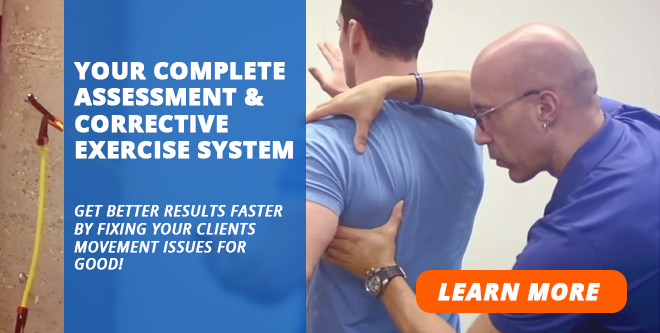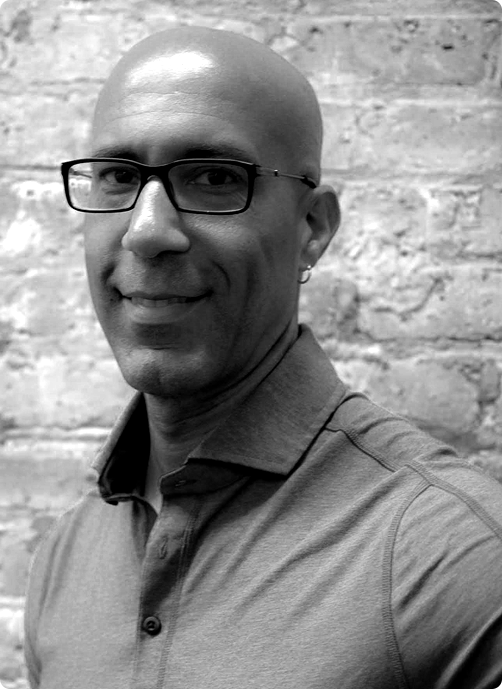Strength Training vs. Corrective Exercise: Which Rules?
Today I have a guest post from Dr. Evan Osar, chiropractic physician, author, and all around awesome resource for learning how the body works and responds to exercise, and also the creator of the new Integrative Corrective Exercise Specialist educational course to help trainers, physiotherapists, athletic therapists, chiropractors and medical doctors have a new opportunity to involve corrective exercise in their training and treatment programs without losing sight of the end goals.
***
Here’s your situation: One of your long-time clients has been experiencing chronic low back pain and has been seen by their chiropractic physician and/or physiotherapist. They have just been cleared to return to exercise and have been told that they need to develop a well-rounded strength training program so they can keep their back strong. You do your assessment, design a well thought out training program, and progressively start working your client through their program. Although your client is progressing well, after a few weeks your client reports they are beginning to notice their usual low back discomfort and chronic hip tightness. They are having a little more back discomfort when they get out of bed in the morning and after they’ve been sitting at their desk for a period of time. They are diligent about stretching every day yet they still report a sensation of feeling ‘tight’ most days.
You speak with your client’s chiropractic physician and/or physiotherapist and they recommend a series of ‘corrective exercises’ prior to each workout to stretch some of the tight things and strengthen some of the weak things they feel is contributing to your client’s back problem. They also want you to work on some things that will improve your client’s posture, as they believe that is also contributing to their problems. You have no problem implementing their suggestions however you realize these corrective exercises take 30 minutes to do which leaves you with only 30 minutes to do strength training. And you wonder how improving their posture will even help their low back pain because you haven’t read any literature that has demonstrated that improving posture actually makes a difference with things like low back pain.
Your client’s primary goal is to get stronger. What do you do?
If you work with the general population clientele – especially baby boomers and seniors – you’ll resonate with the above scenario. In this article, I want to address this very common scenario that strength and conditioning specialists encounter and one that often pits proponents of corrective exercise against its detractors. I will discuss corrective exercise and explain how it can be seamlessly incorporated into a comprehensive strength training program so that you effectively help your general population clients achieve their health and fitness goals…and get stronger in the process.
As strength and conditioning specialists, we often view our role as just that – to get our clients stronger. We have been taught that strength improves performance and concurrently, that strength will prevent injuries. This article is meant to offer a unique perspective on our current concept of strength and the thought process that simply getting stronger is all that is required to improve performance and reduce injury risk.
If you are comparing two individuals of equal ability that are competing against each other and one is stronger than the other, the stronger individual will inevitably lift more weight, run faster, throw further, and generally outperform the ‘weaker’ individual in most objective measurements.
However, when we discuss strength we are rarely comparing individuals of equal ability. Generally one of these individuals isn’t stronger simply because they have gone through a superior training program. It is quite a bit more likely they are ‘stronger’ because they have developed a more efficient strategy. Let me illustrate this point.
Middle eastern and African women carry massive loads on top of their heads for miles upon miles, day after day, without breaking down (experiencing chronic muscle tension and degenerative joint disease).
Virtually every single one of you reading this can out squat, out deadlift, out bench press, out pull up, and out perform these ladies in Turkish get ups. So in other words, you are much ‘stronger’ than these women.
However, I want you to consider the following questions: Could you carry even a 20 pound weight on your head for one mile and not feel significant neck and back discomfort? How about for several miles? How about doing that every single day for the next month? How about your strongest clients? How many of them could do this? I suspect not too many.
So how do these thin and relatively frail women (frail compared to the majority of you reading this) perform this activity without it breaking them down? It comes down to one thing: they have developed and utilize an efficient postural and movement strategy. What do I mean when I am referring to an efficient postural and movement strategy?
An efficient strategy is the ability of your nervous system to collect the information it receives and organize it into a strategy (for both static alignment and dynamic movement) for carrying out the activities you want to perform. It is the ability to centrate (optimally align and control) one’s joints and to breathe efficiently in order to regulate internal pressures required to both stabilize and decompress the trunk, spine, and pelvis.
The more efficient this process, the better one performs. The more efficient the process, the less one gets injured. Therefore efficient posture and movement is the ability to optimally align and control one’s joints and breathe three-dimensionally to meet the demands of life and the tasks one wants to accomplish. With the development of an improved strategy, individuals generally get stronger which is why the benefits of a certain program are often attributed to strength gains.
While this may appear to be simply a discussion of semantics it is important to recognize that improving performance and reducing injury risk is not just about getting stronger. It is about developing an improved strategy so that strength develops upon an efficient strategy. This is what ultimately supports your clients in achieving their goals and this is what will give your clients the best opportunity to lower their risk for developing both acute and accumulative (repetitive) injuries. The less efficient this process, the more one has to compensate and that’s where postural and movement problems arise.
Our health clubs – as well as our chiropractic offices, physical therapy clinics, and medical offices – are filled with ‘strong’ individuals. It is often when an individual’s strategy can no longer match their strength and/or desired outcomes that they usually develop problems. This is why I believe we are seeing increasing numbers of acute and chronic injuries in recent years in individuals that are performing HIIT training programs. Often these are the clients and patients that will tell me they have gotten progressively stronger doing their favorite HIIT program so they feel frustrated as to why they keep experiencing chronic tightness and/or discomfort. It is also why I believe that we have seen virtually no change in the incidence of low back pain even though our industry has spent the last decade improving core ‘strength’.
Unfortunately a similar problem is affecting our youth athletes. We are seeing younger and younger clients with disc injuries, hip labral tears, degenerative joint changes, sports hernias, and other signs of non-optimal postural and movement strategies that we used to only see in our baby boomer and senior clients. I have evaluated increasing numbers of teenage athletes with hip labral tears that have gone through well-designed strengthening programs and have indeed gotten stronger, yet they quickly get injured once they participate in their sport. The problem for these individuals is that although they got stronger, they did not develop an optimal strategy which lead to an injury once the demands of the activity increased. It wasn’t that they didn’t develop enough strength or that they didn’t follow an appropriate pre-participation program, it is that their program didn’t adequately address the underlying problem(s) of their non-optimal posture and movement strategy. And there are often times that we find that the program itself has caused the individual to develop a non-optimal strategy by improperly progressing, cuing, and/or executing the fundamental patterns.
To best help our clients develop a proper foundation to build strength, our goal is first and foremost to help them achieve an improved postural and movement strategy. The goal of our programs is never to ‘fix’ them or ‘correct’ them, or make them ‘perfect’. In our paradigm, we use a corrective exercise approach, rather than a series of exercises, as a means for helping our clients develop a more optimal posture and movement strategy. Generally the strategy for how a client stands is usually consistent with how a client sits and how they bend, and how they squat, and how they lift, etc. In other words, the individual is consistent in using the similar postural and movement habit throughout many of their activities of life including occupation, recreation, and sport.
Therefor, we view corrective exercise as a systematic approach that:
- identifies the key factors contributing to an individual’s current non-optimal postural and movement habits
- utilizes specific release and/or activation techniques to address the individual’s primary issues that are driving their chronic problems or loss of performance (these are the factors we discover that are directly contributing to postural and movement dysfunction, loss of strength, and/or decreased performance)
- incorporates the principles of the Integrative Movement System™ – alignment, breathing, and control – into the fundamental movement patterns of squatting, lunging, bending, rotating, pushing, pulling, and gait so the individual can accomplish their health and fitness goals
Corrective exercise then is not a series of remedial exercises designed to diagnose or identify the ‘fix’ for your client’s issues. It is a strategy for implementing a thorough assessment, implementing the appropriate releases and/or activation sequences so that your client can achieve optimal alignment, breathing, and control, and then integrate these principles into the fundamental movement patterns and/or your client’s functional goals.
Used judiciously, corrective exercise is a part of an overall training strategy designed to look at your client as an individual and provide them with a valuable option for successfully addressing their issues while working towards their functional goals. Therefor, corrective exercise should enhance and not deter from improving strength, mobility, speed, endurance, or any other objective outcome. When you understand and integrate a successful corrective exercise strategy, you will help many clients who have been struggling with chronic issues, safely and effectively accomplish their individual health and fitness goals.
Returning to our earlier discussion of your client with back pain – how much time should be spent with corrective exercise? The amount of time you spend with corrective exercise is dependent upon your client’s current strategy and how much time is required to help them achieve a more efficient strategy – in other words, better align and control their joints and develop improved three-dimensional breathing. Those clients with complicated medical history’s and/or who require more motor control training, need more time focused upon the corrective exercise component of their program as that is what will give them the best opportunity for developing an improved strategy. Those with less complicated histories and/or have better motor control, require less time.
Regardless of where a client is or where they are going, all clients will need to be progressed through the fundamental movement patterns so they can ultimately achieve their functional goals. What varies between individuals is how quickly they are progressed. That is where the magic occurs in this corrective exercise approach or any strength training program for that matter: it is not in the exercises or in getting clients simply to be stronger. The magic (dramatic and often profound or long-stranding changes) occurs by using the proper progressions while respecting that your client maintains optimal alignment, breathing, and control throughout their patterns.
One final point: You will undoubtedly come across the outliers – those who have what would be considered non-optimal posture and movement habits – and still are incredibly strong and/or haven’t experienced a lot of injuries. These are usually the individuals the detractors of corrective exercise often point to. It is important to recognize that these individuals are few and far between. Most of your general population clients are not the outliers – they are individuals that because of their habits and compensations from previous injuries, traumas, surgeries, inactivity, and/or poor exercise habits, have a need to develop a more efficient postural and movement strategy.
While the client will likely never come in and tell you that their functional goal is ‘I need to develop a more efficient postural and movement strategy’, if they mention that they are experiencing chronic tightness, chronic discomfort, and/or the loss of performance, they are is essence telling you that they are indeed looking for a strength and conditioning specialist that can help them in that process.
In conclusion, when all things are equal – i.e. the individual has an optimal posture and movement strategy – strength will improve performance and aid in the prevention of injuries. However, as I’ve illustrated in this article, long term improvements in strength with a concurrent lower risk of injury will only occur when someone has developed strength upon the foundation of optimal alignment, breathing, and control. Strength developed upon a faulty foundation will only perpetuate an individual’s current postural and movement problems and is eventually what will break them down. Strength developed upon a solid foundation of alignment, breathing, and control will allow your client to not only develop strength, it will enable them to address the issues that have held them back and contributed to their postural and movement issues. Working from this corrective exercise paradigm will help your clients achieve their health and fitness goal(s) and get stronger in the process!
About the Author
Audiences around the world have seen Dr. Evan Osar’s dynamic and original presentations. His passion for improving human movement and helping fitness professionals think bigger about their role can be witnessed in his writing and experienced in every course he teaches. His 20-year background in the fitness industry and experience as a chiropractic physician provide a unique perspective on corrective exercise and fundamental training principles for the health and fitness professional that works with the pre and post-rehabilitation, pre and post-natal, baby boomer and senior populations. Dr. Osar has become known for taking challenging information and putting it into useable information the health and fitness professional can apply immediately with their clientele.
His newest resource, the Integrative Corrective Exercise Specialist online portal, is set to become the new standard in education for those looking to begin or continue working with clients who have musculoskeletal limitations and are looking to improve their fitness. I’ve personally gone through the modules and can say there isn’t anything on the market that can currently come close to the quality, depth and breadth of information, and overall usability of the information. It’s on a short term launch discount until the end of this week, so act quickly.
Get the Integrative Corrective Exercise Specialist NOW!!



One Response to Strength Training vs. Corrective Exercise: Which Rules?